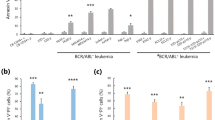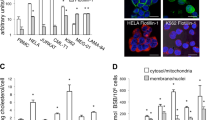Abstract
The stilbene phytochemicals resveratrol and piceatannol have been reported to possess substantial antitumorigenic and antileukemic activities, respectively. Although recent experimental data revealed the proapoptotic potency of resveratrol, the molecular mechanisms underlying the antileukemic activity have not yet been studied in detail. In the present study, we show that resveratrol, as well as the hydroxylated analog piceatannol, are potent inducers of apoptotic cell death in BJAB Burkitt-like lymphoma cells with an ED50 concentration of 25 μM. Further experiments revealed that treatment of BJAB cells with both substances led to a concentration-dependent activation of caspase-3 and mitochondrial permeability transition. Using BJAB cells overexpressing a dominant-negative mutant of the Fas-associated death domain (FADD) adaptor protein to block death receptor-mediated apoptosis, we demonstrate that resveratrol- and piceatannol-induced cell death in these cells is independent of the CD95/Fas signaling pathway. To explore the antileukemic properties of both compounds in more detail, we extended our study to primary, leukemic lymphoblasts. Interestingly, piceatannol but not resveratrol is a very efficient inducer of apoptosis in this ex vivo assay with leukemic lymphoblasts of 21 patients suffering from childhood lymphoblastic leukemia (ALL).
This is a preview of subscription content, access via your institution
Access options
Subscribe to this journal
Receive 12 print issues and online access
$259.00 per year
only $21.58 per issue
Buy this article
- Purchase on Springer Link
- Instant access to full article PDF
Prices may be subject to local taxes which are calculated during checkout








Similar content being viewed by others
References
Hartwell JL . Plants used against cancer. A survey Lloydia 1969 32: 153–205
Fremont L . Biological effects of resveratrol Life Sci 2000 66: 663–673
Ferrigni NR, McLaughlin JL, Powell RG, Smith CR . Use of potato disc and brine shrimp bioassays to detect activity and isolate piceatannol as the antileukemic principle from the seeds of Euphorbia lagascae J Nat Prod 1984 47: 347–352
Gaziano JM, Buring JE, Breslow JL, Goldhaber SZ, Rosner B, VanDenburgh M, Willett W, Hennekens CH . Moderate alcohol intake, increased levels of high-density lipoprotein and its subfractions, and decreased risk of myocardial infarction N Engl J Med 1993 329: 1829–1834
Rimm EB, Klatsky A, Grobbee D, Stampfer MJ . Review of moderate alcohol consumption and reduced risk of coronary heart disease: is the effect due to beer, wine, or spirits Br Med J 1996 312: 731–736
Jang M, Cai L, Udeani GO, Slowing KV, Thomas CF, Beecher CW, Fong HH, Farnsworth NR, Kinghorn AD, Mehta RG, Moon RC, Pezzuto JM . Cancer chemopreventive activity of resveratrol, a natural product derived from grapes Science 1997 275: 218–220
Clement MV, Hirpara JL, Chawdhury SH, Pervaiz S . Chemopreventive agent resveratrol, a natural product derived from grapes, triggers CD95 signaling-dependent apoptosis in human tumor cells Blood 1998 92: 996–1002
Huang C, Ma WY, Goranson A, Dong Z . Resveratrol suppresses cell transformation and induces apoptosis through a p53-dependent pathway Carcinogenesis 1999 20: 237–242
Surh YJ, Hurh YJ, Kang JY, Lee E, Kong G, Lee SJ . Resveratrol, an antioxidant present in red wine, induces apoptosis in human promyelocytic leukemia (HL-60) cells Cancer Lett 1999 140: 1–10
Arends MJ, Wyllie AH . Apoptosis: mechanisms and roles in pathology Int Rev Exp Pathol 1991 32: 223–254
Daniel PT . Dissecting the pathways to death Leukemia 2000 14: 2035–2044
Hickman JA . Apoptosis and chemotherapy resistance Eur J Cancer 1996 32A: 921–926
Hannun YA . Apoptosis and the dilemma of cancer chemotherapy Blood 1997 89: 1845–1853
Prokop A, Wieder T, Sturm I, Essmann F, Seeger K, Wuchter C, Ludwig W-D, Henze G, Dörken B, Daniel PT . Relapse in childhood acute lymphoblastic leukemia is associated with a decrease of the Bax/Bcl-2-ratio and loss of spontaneous caspase-3 processing in vivo Leukemia 2000 14: 1606–1613
Raisova M, Bektas M, Wieder T, Daniel P, Eberle J, Orfanos CE, Geilen CC . Resistance to CD95/Fas-induced and ceramide-mediated apoptosis of human melanoma cells is caused by a defective mitochondrial cytochrome c release FEBS Lett 2000 473: 27–32
Geahlen RL, McLaughlin JL . Piceatannol (3,4,3′,5′-tetrahydroxy-trans-stilbene) is a naturally occurring protein-tyrosine kinase inhibitor Biochem Biophys Res Commun 1989 165: 241–245
Oliver JM, Burg DL, Wilson BS, McLaughlin JL, Geahlen RL . Inhibition of mast cell Fc epsilon R1-mediated signaling and effector function by the Syk-selective inhibitor, piceatannol J Biol Chem 1994 269: 29697–29703
Brumbaugh KM, Binstadt BA, Billadeau DD, Schoon RA, Dick CJ, Ten RM, Leibson PJ . Functional role for Syk tyrosine kinase in natural killer cell-mediated natural cytotoxicity J Exp Med 1997 186: 1965–1974
Law DA, Nannizzi-Alaimo L, Ministri K, Hughes PE, Forsyth J, Turner M, Shattil SJ, Ginsberg MH, Tybulewicz VL, Phillips DR . Genetic and pharmacological analyses of Syk function in alphaIIbbeta3 signaling in platelets Blood 1999 93: 2645–2652
Wang BH, Lu ZX, Polya GM . Inhibition of eukaryote serine/threonine-specific protein kinases by piceatannol Planta Med 1998 64: 195–199
Thakkar K, Geahlen RL, Cushman M . Synthesis and protein-tyrosine kinase inhibitory activity of polyhydroxylated stilbene analogues of piceatannol J Med Chem 1993 36: 2950–2955
Wieder T, Essmann F, Prokop A, Schmelz K, Schulze-Osthoff K, Beyaert R, Dörken B, Daniel PT . Activation of caspase-8 in drug-induced apoptosis of B-lymphoid cells is independent of CD95/Fas receptor-ligand interaction and occurs downstream of caspase-3 Blood 2001 97: 1378–1387
Béné MC, Castoldi G, Knapp W, Ludwig WD, Matutes E, Orfao A, van't Veer MB . Proposals for the immunological classification of acute leukemias. European Group for the Immunological Characterization of Leukemias (EGIL) Leukemia 1995 9: 1783–1786
Schrappe M, Reiter A, Henze G, Niemeyer C, Bode U, Kuhl J, Gadner H, Havers W, Pluss H, Kornhuber B, Zintl F, Ritter J, Urban C, Niethammer D, Riehm H . Prevention of CNS recurrence in childhood ALL: results with reduced radiotherapy combined with CNS-directed chemotherapy in four consecutive ALL-BFM trials Klin Padiatr 1998 210: 192–199
Seeger K, Adams HP, Buchwald D, Beyermann B, Kremens B, Niemeyer C, Ritter J, Schwabe D, Harms D, Schrappe M, Henze G . TEL-AML1 fusion transcript in relapsed childhood acute lymphoblastic leukemia. The Berlin–Frankfurt–Munster Study Group Blood 1998 91: 1716–1722
Dordelmann M, Reiter A, Borkhardt A, Ludwig WD, Gotz N, Viehmann S, Gadner H, Riehm H, Schrappe M . Prednisone response is the strongest predictor of treatment outcome in infant acute lymphoblastic leukemia Blood 1999 94: 1209–1217
Bantel H, Engels IH, Voelter W, Schulze-Osthoff K, Wesselborg S . Mistletoe lectin activates caspase-8/FLICE independently of death receptor signaling and enhances anticancer drug-induced apoptosis Cancer Res 1999 59: 2083–2090
Wieder T, Orfanos CE, Geilen CC . Induction of ceramide-mediated apoptosis by the anticancer phospholipid analog, hexadecylphosphocholine J Biol Chem 1998 273: 11025–11031
Essmann F, Wieder T, Otto A, Müller EC, Dörken B, Daniel PT . GDP dissociation inhibitor D4-GDI (Rho-GDI 2), but not the homologous Rho-GDI 1, is cleaved by caspase-3 during drug-induced apoptosis Biochem J 2000 346: 777–783
Smith PK, Krohn RI, Hermanson GT, Mallia AK, Gartner FH, Provenzano MD, Fujimoto EK, Goeke NM, Olson BJ, Klenk DC . Measurement of protein using bicinchoninic acid Anal Biochem 1985 150: 76–85
Laemmli UK . Cleavage of structural proteins during the assembly of the head of bacteriophage T4 Nature 1970 227: 680–685
Wieder T, Geilen CC, Wieprecht M, Becker A, Orfanos CE . Identification of a putative membrane-interacting domain of CTP:phosphocholine cytidylyltransferase from rat liver FEBS Lett 1994 345: 207–210
Lambert IH, Hoffmann EK, Jorgensen F . Membrane potential, anion and cation conductances in Ehrlich ascites tumor cells J Membr Biol 1989 111: 113–131
Reers M, Smiley ST, Mottola-Hartshorn C, Chen A, Lin M, Chen LB . Mitochondrial membrane potential monitored by JC-1 dye Meth Enzymol 1995 260: 406–417
Cohen GM . Caspases: the executioners of apoptosis Biochem J 1997 326: 1–16
Los M, Wesselborg S, Schulze-Osthoff K . The role of caspases in development, immunity, and apoptotic signal transduction: lessons from knockout mice Immunity 1999 10: 629–639
Li H, Zhu H, Xu CJ, Yuan J . Cleavage of BID by caspase 8 mediates the mitochondrial damage in the Fas pathway of apoptosis Cell 1998 94: 491–501
Wada M, Bartram CR, Nakamura H, Hachiya M, Chen DL, Borenstein J, Miller CW, Ludwig L, Hansen-Hagge TE, Ludwig WD, Reiter A, Mizoguchi H, Koeffler HP . Analysis of p53 mutations in a large series of lymphoid hematologic malignancies of childhood Blood 1993 82: 3163–3169
Kawamura M, Ohnishi H, Guo SX, Sheng XM, Minegishi M, Hanada R, Horibe K, Hongo T, Kaneko Y, Bessho F, Yanagisawa M, Sekiya T, Hayashi Y . Alterations of the p53, p21, p16, p15 and RAS genes in childhood T-cell acute lymphoblastic leukemia Leuk Res 1999 23: 115–126
Manna SK, Mukhopadhyay A, Aggarwal BB . Resveratrol suppresses TNF-induced activation of nuclear transcription factors NF-kappa B, activator protein-1, and apoptosis: potential role of reactive oxygen intermediates and lipid peroxidation J Immunol 2000 164: 6509–6519
Zheng J, Ramirez VD . Piceatannol, a stilbene phytochemical, inhibits mitochondrial F0F1-ATPase activity by targeting the F1 complex Biochem Biophys Res Commun 1999 261: 499–503
Zheng J, Ramirez VD . Inhibition of mitochondrial proton F0F1-ATPase/ATP synthase by polyphenolic phytochemicals Br J Pharmacol 2000 130: 1115–1123
Kroemer G, Reed JC . Mitochondrial control of cell death Nat Med 2000 6: 513–519
Scaffidi C, Schmitz I, Zha J, Korsmeyer SJ, Krammer PH, Peter ME . Differential modulation of apoptosis sensitivity in CD95 type I and type II cells J Biol Chem 1999 274: 22532–22538
Dorrie J, Gerauer H, Wachter Y, Zunino SJ . Resveratrol induces extensive apoptosis by depolarizing mitochondrial membranes and activating caspase-9 in acute lymphoblastic leukemia cells Cancer Res 2001 61: 4731–4739
Tinhofer I, Bernhard D, Senfter M, Anether G, Loeffler M, Kroemer G, Kofler R, Csordas A, Greil R . Resveratrol, a tumor-suppressive compound from grapes, induces apoptosis via a novel mitochondrial pathway controlled by Bcl-2 Faseb J 2001 15: 1613–1615
Godichaud S, Krisa S, Couronne B, Dubuisson L, Merillon JM, Desmouliere A, Rosenbaum J . Deactivation of cultured human liver myofibroblasts by trans-resveratrol, a grapevine-derived polyphenol Hepatology 2000 31: 922–931
Friedrich K, Wieder T, von Haefen C, Radetzki S, Jänicke R, Schulze-Osthoff K, Dörken B, Daniel PT . Overexpression of caspase-3 restores sensitivity for drug-induced apoptosis in breast cancer cell lines with acquired drug resistance Oncogene 2001 20: 2749–2760
Gautam SC, Xu YX, Dumaguin M, Janakiraman N, Chapman RA . Resveratrol selectively inhibits leukemia cells: a prospective agent for ex vivo bone marrow purging Bone Marrow Transplant 2000 25: 639–645
Acknowledgements
This work was supported by grants from the Deutsche Forschungsgemeinschaft (SFB 273 and SFB 506) to PTD, the European Community TMR Programme to PTD and K-SO, the Deutsche José Carreras Leukämie-Stiftung eV to PTD, TW and AP, the Verein zur Förderung der Tagesklinik eV and the Berliner Krebsgesellschaft eV to TW and AP. The help of Lucia Badiali, Astrid Burneleit, Wilhelm Geilen, Marianne Loewke-Wolff, Richard Schabath, Karlheinz Seeger, Katharina Weber and Renate Wolf in the collection and preparation of patient samples is gratefully acknowledged.
Author information
Authors and Affiliations
Rights and permissions
About this article
Cite this article
Wieder, T., Prokop, A., Bagci, B. et al. Piceatannol, a hydroxylated analog of the chemopreventive agent resveratrol, is a potent inducer of apoptosis in the lymphoma cell line BJAB and in primary, leukemic lymphoblasts. Leukemia 15, 1735–1742 (2001). https://doi.org/10.1038/sj.leu.2402284
Received:
Accepted:
Published:
Issue Date:
DOI: https://doi.org/10.1038/sj.leu.2402284
Keywords
This article is cited by
-
Complexation behaviour of piceatannol ligand with Ti(IV) and Zr(IV) metal ions: a combined DFT and deep learning investigation
Structural Chemistry (2023)
-
Reverse chemomodulatory effects of the SIRT1 activators resveratrol and SRT1720 in Ewing’s sarcoma cells: resveratrol suppresses and SRT1720 enhances etoposide- and vincristine-induced anticancer activity
Journal of Cancer Research and Clinical Oncology (2016)
-
Analysis of the anti-proliferative and the pro-apoptotic efficacy of Syk inhibition in multiple myeloma
Experimental Hematology & Oncology (2015)
-
Synthesis and antitumor activity of 7-(triazol-1-yl)pyrroloallocolchicine derivatives
Russian Chemical Bulletin (2015)
-
The rare-earth yttrium complex [YR(mtbmp)(thf)] triggers apoptosis via the extrinsic pathway and overcomes multiple drug resistance in leukemic cells
Medical Oncology (2012)



